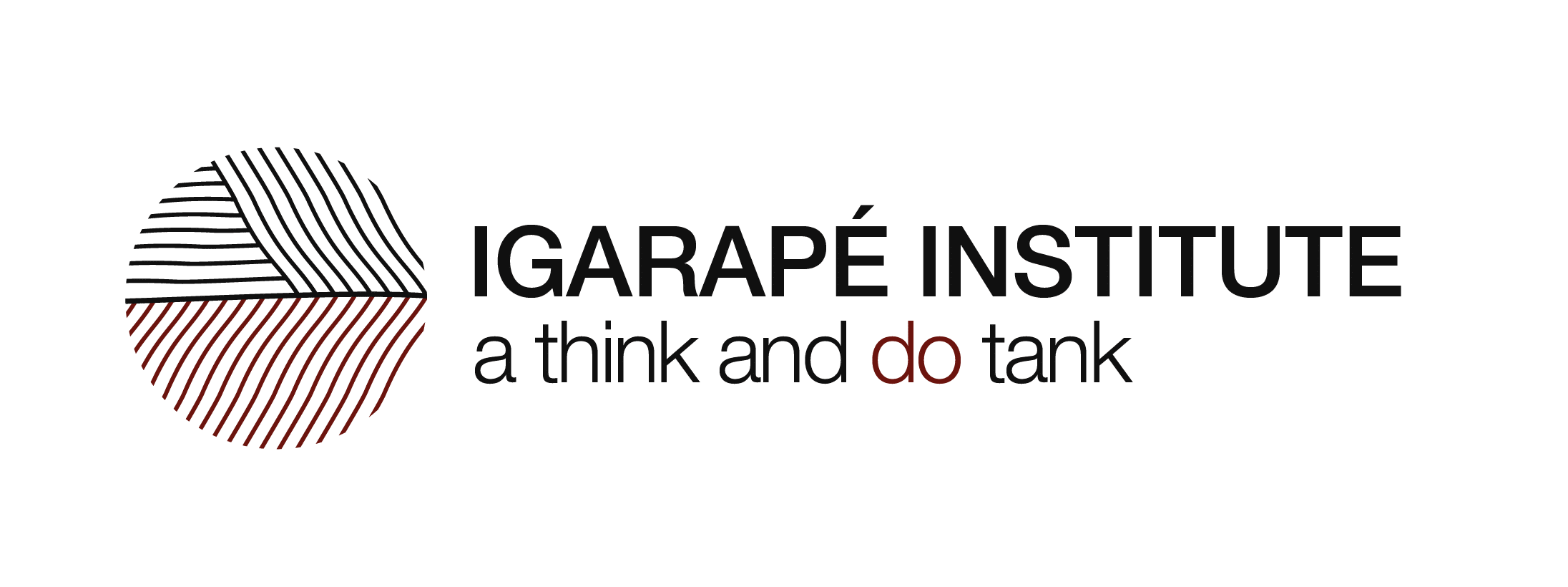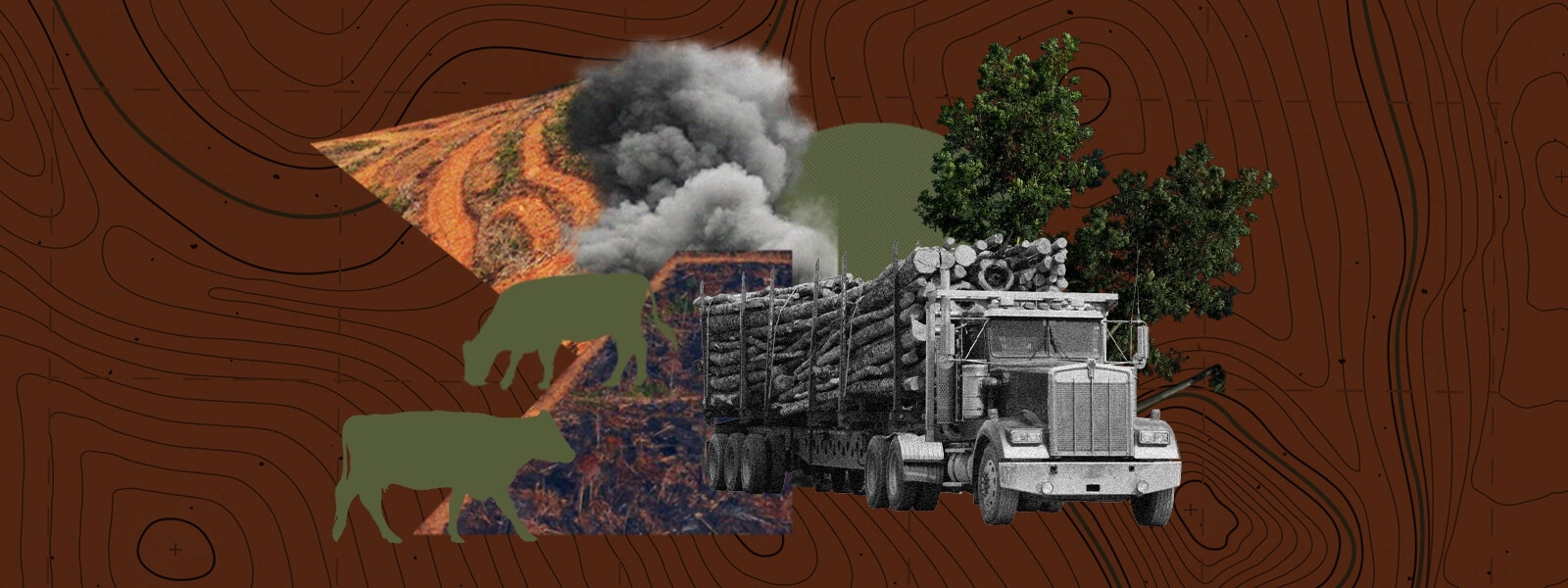With almost 70 million hectares of forest, the Peruvian Amazon covers more than half of the country’s territory. The region extends from north to south across the departments of Loreto, Amazonas, San Martín, Ucayali and Madre de Dios. Another ten departments overlap with the Amazon region: Cajamarca, Huancavelica, La Libertad, Pasco, Piura, Puno, Ayacucho, Junín, Cusco and Huánuco.

*InSight Crime has partnered with the Igarapé Institute – an independent think tank headquartered in Brazil, that focuses on emerging development, security and climate issues – to trace the environmental crimes and criminal actors driving deforestation in Peru’s Amazon. See the entire six-part series here or download the full PDF.
As a resource-rich forest, the Peruvian Amazon is being plundered at an accelerated rate. In 2020, Peru reached the highest levels of deforestation in the country’s history, with a total of 203,272 hectares razed, almost 40 percent more than in 2019.
Prior to this surge, from 2017 to 2019, the country exhibited constant deforestation rates of around 150,000 hectares per year, which is equivalent to an annual tree-cover loss of 19 percent.
Today, Peru ranks as the country with the fifth highest rate of deforestation in the world and the third highest in the Amazon, behind Brazil and Bolivia. In all, Peru has lost more than 26,000 square-kilometers of forest since 2001, an area greater than the size of El Salvador.
The areas most affected by deforestation fall within the Amazon basin and are concentrated in Indigenous communities in the departments of Ucayali, Pasco, Junín and Huánuco, in the center of the country; in Loreto, in the north; and Madre de Dios, in southeastern Peru. The high levels of deforestation have many causes, not least of which is the near chronic political crisis and power vacuum that have assailed Peru in recent years. The political chaos has undercut the fight against deforestation and environmental crimes, pushing these issues down the agenda.
SEE ALSO: Coverage of Environmental Crime
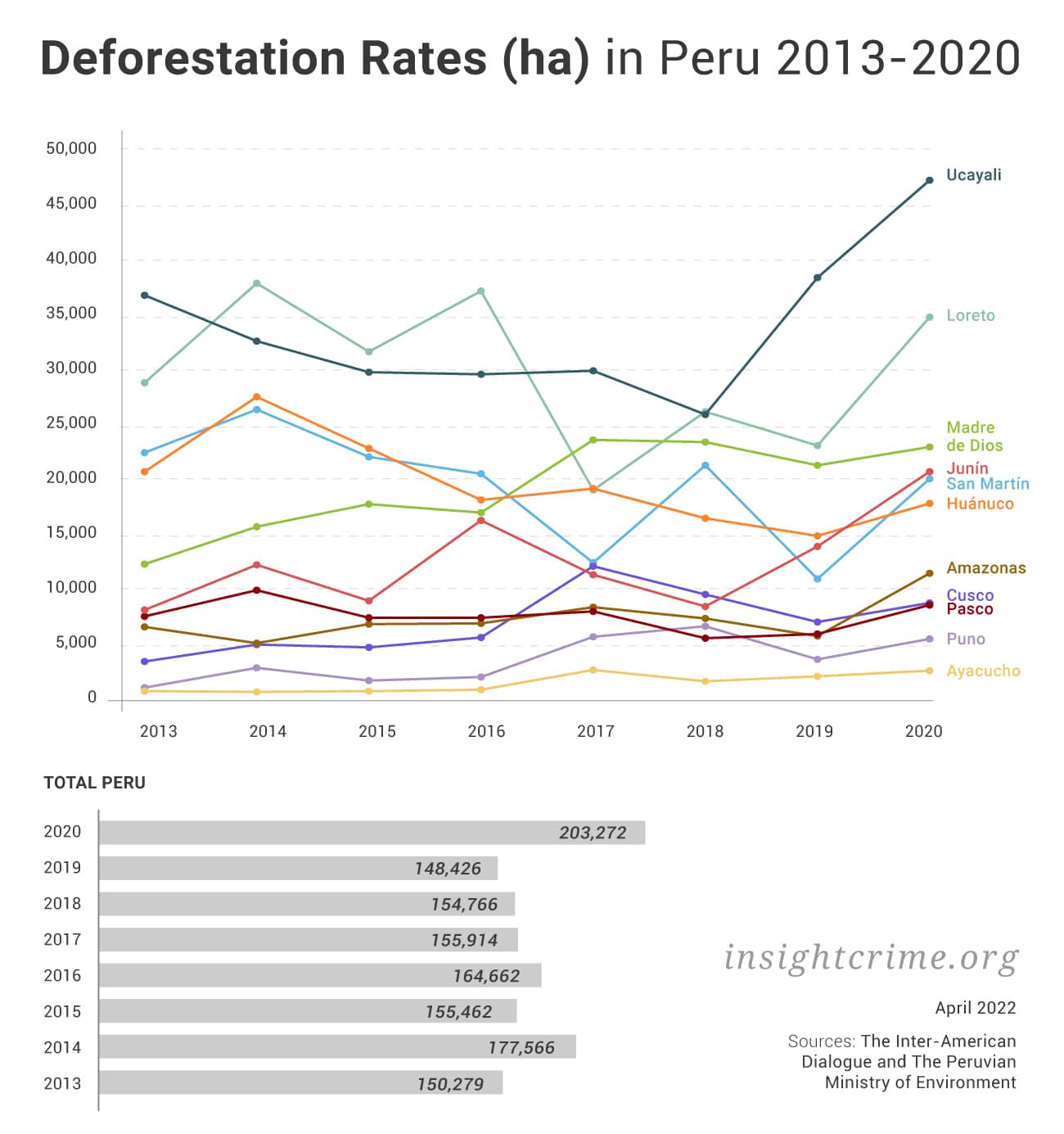
The pandemic has also been a key factor in the record deforestation, turning government attention away from environmental protection and inviting rampant environmental crime.
“COVID-19 pushed people from urban areas into the jungle,” says former Interior Minister Carlos Basombrío.
However, the ugly truth is that ecological destruction in the Amazon is part of a larger battle that dates back decades. Countries like Peru struggle to balance the need to promote economic growth with the need to protect the fragile ecosystems increasingly responsible for that growth.
“There [in the Amazon], many have taken up activities that cause deforestation, such as agriculture or mining,” Basombrío adds.
Cattle and Agricultural Activities in the Peruvian Amazon
Land in the Peruvian Amazon is divided among private property holders, Indigenous communities and the public domain. A cross-section of national and local government agencies administer these lands. At the national level, the Ministry of Agriculture sells or grants land for logging and agribusiness. At the local level, Regional Agricultural Directorates (Direcciones Regionales Agrarias – DRAs) administer lands within their jurisdictions. The DRAs grant land-ownership certificates via what are known as Directorates for the Physical and Legal Regularization of Agricultural Property (Direcciones de Saneamiento Físico Legal de la Propiedad Agraria). The directorates provide the documents that allow settlers to acquire land in the Amazon on which they can develop agricultural activities, and then, having worked on said land, they may obtain a property title.
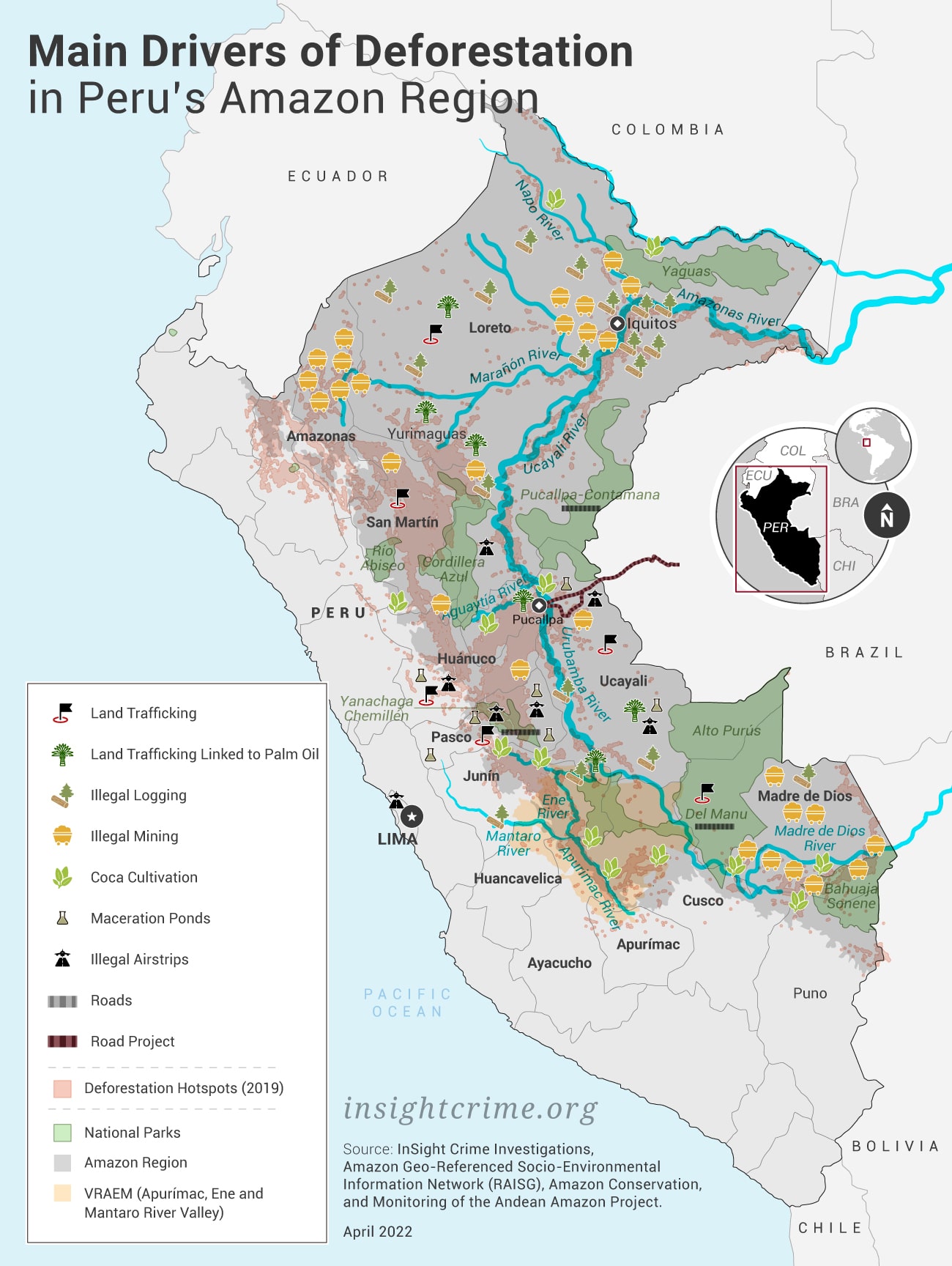
While the Amazon basin has long been exploited, the government of Alberto Fujimori (1990-2009) opened the doors to small-, medium- and large-scale agriculture in the Peruvian Amazon. In the Amazon, Fujimori did not see the lungs of the planet but an area ripe for economic development. As such, he promoted foreign private investment in the region. He also changed the legislation regarding land ownership and the use of forest land to, as economists Roxana Barrantes and Manuel Glave describe it, “achieve the long-awaited development of the Peruvian Amazon” through agricultural and extractive activities.
“Fujimori had the belief the Amazon was an ‘idle land’ that should be exploited. One way to do so was through agricultural activities,” explained Magaly Ávila, the director of the forest governance program for Proética, the Peruvian chapter of Transparency International.
Since then, the Peruvian Amazon has grappled with pressure from two fronts. On one front, small farmers invade areas of the Amazon and clear swaths of land to make way for cattle ranching and other agricultural activities. These settlers often start with small plots of up to ten hectares. However, these small settlements have a way of multiplying and are sometimes converted into large-scale agricultural farms.
“We have seen how those ten hectares multiply and become 2,000,” says Julio Guzmán, an attorney for Peru’s Ministry of the Environment. “This has had a devastating effect.”
On the other front, agro-industrial companies have entered the region. These companies fill the surging international demand for commodities such as palm oil, which is used in cosmetics and food products. Palm oil plantations have grown by 95 percent during the last ten years in Peru. Large agribusiness has led to deforestation in Loreto and San Martín in the north; Ucayali, Huánuco and Pasco, in the central part of the country; and Madre de Dios, in southeastern Peru.
Land trafficking fuels the development of small- and large-scale agricultural activities. As happens throughout the region, land traffickers in Peru take advantage of existing legal loopholes or get help from regional government officials to buy and sell tracks of land. In most cases, these officials grant land titles to agro-industrial companies for parcels of land that historically belong to Indigenous communities. Despite inhabiting lands for years, Indigenous communities often do not have land titles, making them ripe targets for these officials and traffickers.
To cite just one example, Mongabay and Proética have reported on how, since 2012, the Indigenous community of Santa Clara de Uchunya, in Ucayali, has been cornered by a company once known as Plantaciones Pucallpa. The company, which has since changed its name to the Ocho Sur P.S.A.C, is dedicated to the production of palm oil. Mongabay reported that this company bought land from land traffickers who invaded the community’s territory, deforested it and then requested the land title from the DRA. Community leaders also reported being the target of threats from these land traffickers.
The results were devastating for the Santa Clara de Uchunya Indigenous community, which claimed a land area of 86,713 hectares. However, the Peruvian government recognized only around 2,000 hectares of their claim. Meanwhile, the rest was subdivided into hundreds of individual properties and sold to Ocho Sur. By the end of 2020, according to a report by the Inter-American Commission on Human Rights, the company had appropriated 6,845 hectares belonging to the community’s ancestral territory. Between 2012 and 2015, the company cleared 7,000 hectares of forest. These accusations against agro-industrial companies will be discussed in greater detail later in this report.
Watchdog groups say the pattern has been repeated elsewhere in the Peruvian Amazon.
“When agro-industrial companies begin to enter Peru, particularly palm oil companies, communities begin to feel a strong pressure in their territories,” says Proética’s Magaly Ávila.
A Coca Producer
Peru has for centuries been a major producer of coca, the raw material for cocaine, and it has been an exporter of cocaine since the nineteenth century. The United States government outlawed cocaine in the early twentieth century and pressured the Amazon nation into doing so in 1948. Peru later became a signatory to the 1961 United Nations Single Convention, which first scheduled coca and cocaine on an international level.
An illegal drug trade emerged, which by 1975 was centered in the Huallaga Valley, in the north of the country. In the early 2000s, this trade shifted to the Valley of the Apurímac, Ene, and Mantaro Rivers. The VRAEM, as it is known for its Spanish acronym, is a region made up of 61 districts around the departments of Junín, Cusco, Ayacucho, Apurímac and Huancavelica, in the south of the country.
Today, Peru is the world’s second largest producer of coca. Production has “spread across the Amazon,” according to Peru’s anti-drug prosecutor, Sonia Medina. The minimal state presence, forced eradication and constant counter-narcotics operations in the VRAEM are among the many reasons behind the reconfiguration of the drug production landscape.
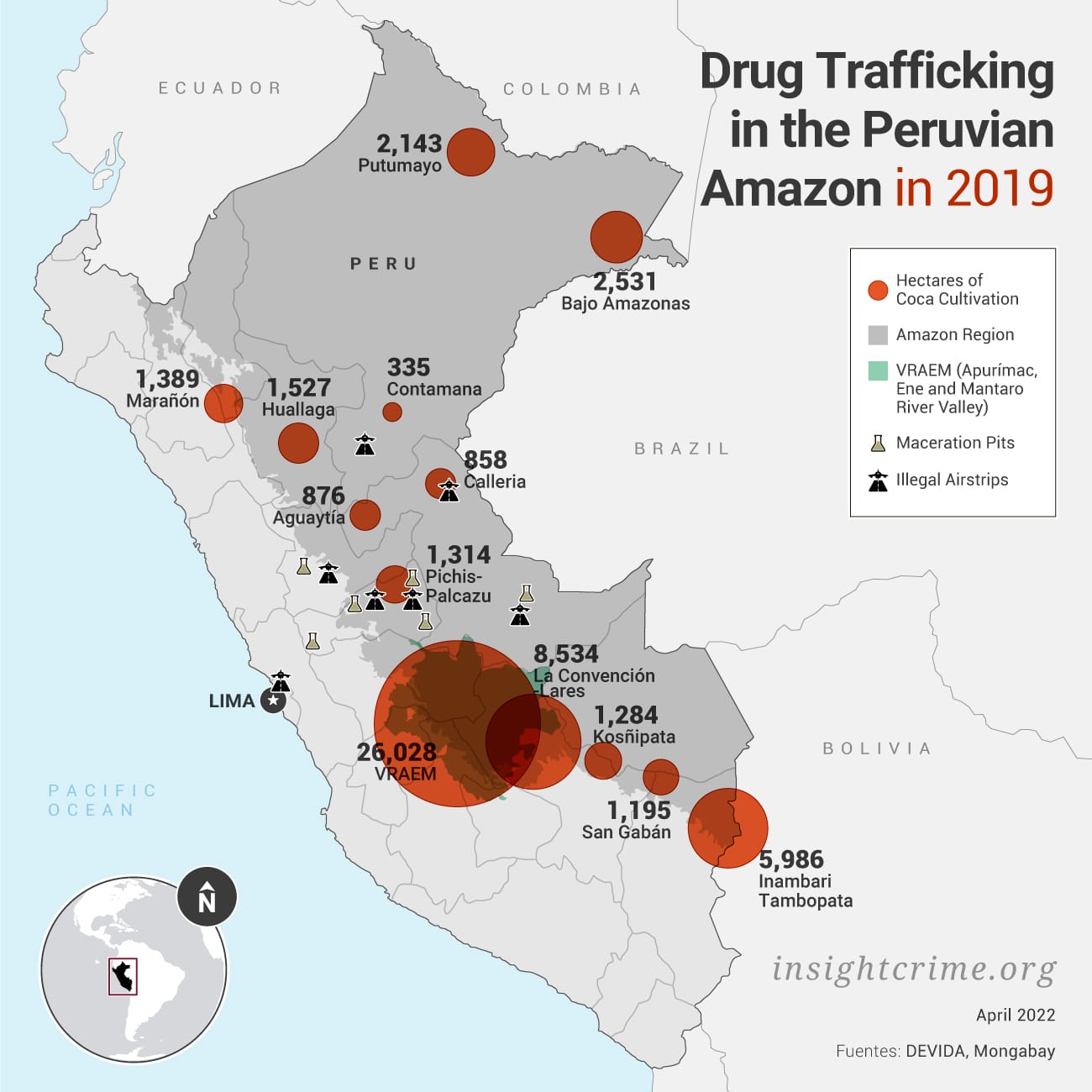
To make space for coca fields, forests are being felled and burned in the departments of Ucayali, Loreto, Huánuco and Pasco, in addition to the Amazon Trapezoid where Peru borders Brazil and Colombia. Other parts of the cocaine process also contribute to deforestation. Laboratories have sprung up around the coca plantations in the Amazon to convert coca leaves into cocaine. And clandestine airstrips have been built to facilitate drug trafficking.
One proxy measure for this growth is to count illegal airstrips. To cite just one example, 46 illegal airstrips were officially detected in Ucayali in 2020, and security expert Pedro Yaranga said there could be more than 80 in that department alone. In 2020, meanwhile, 42,000 hectares of forest loss were reported throughout Ucayali.
According to Chris Fagan, director of the Upper Amazon Conservancy, an organization dedicated to protecting the Amazon rainforest, coca growers are also clearing forests in the Alto Purús and Manu national parks, in southeast Peru. The same has happened in other areas to the southeast of the country, like the Bahuaja-Sonene National Park, and in the areas between Madre de Dios and Puno.
The expansion of drug trafficking in the Amazon has also turned the Indigenous leaders and environmental defenders who oppose drug trafficking into targets. Since the beginning of the pandemic, nearly 20 local leaders have been killed, and an untold number of them have been threatened.
The Timber Trade
The logging industry provides thousands of jobs and is a core part of the Peruvian Amazon economy. Much of the timber extracted in the region is used domestically for construction or for making furniture, while a small percentage feeds foreign markets, principally China. Authorized logging sites include concessions in the Peruvian Amazon, which are found in what are known as Permanent Production Forests (Bosques de Producción Permanente). These are lands in the public domain that are granted in concessions by the Ministry of Agriculture. The Technical Forestry and Wildlife Administrations (Administraciones Técnicas Forestales y de Fauna Silvestre – ATFFS), which are part of departmental governments, also grant harvesting permits to Indigenous communities or to others in what are called Local Forests (Bosques Locales).
However, most of the wood harvested in Peru may be illegally sourced. Indeed, some forestry experts estimate that as much as 80 percent of Peruvian timber is of illegal origin. And the Supervisory Agency for Forest Resources and Wildlife (Organismo de Supervisión de los Recursos Forestales y de Fauna Silvestre – OSINFOR), the entity that oversees and controls forestry and wildlife use, believes that close to 90 percent of illegal logging in Peru takes place in the Amazonian departments of Loreto, Madre de Dios and Ucayali. The remaining ten percent takes place in the departments of Amazonas and San Martín, in northern Peru.
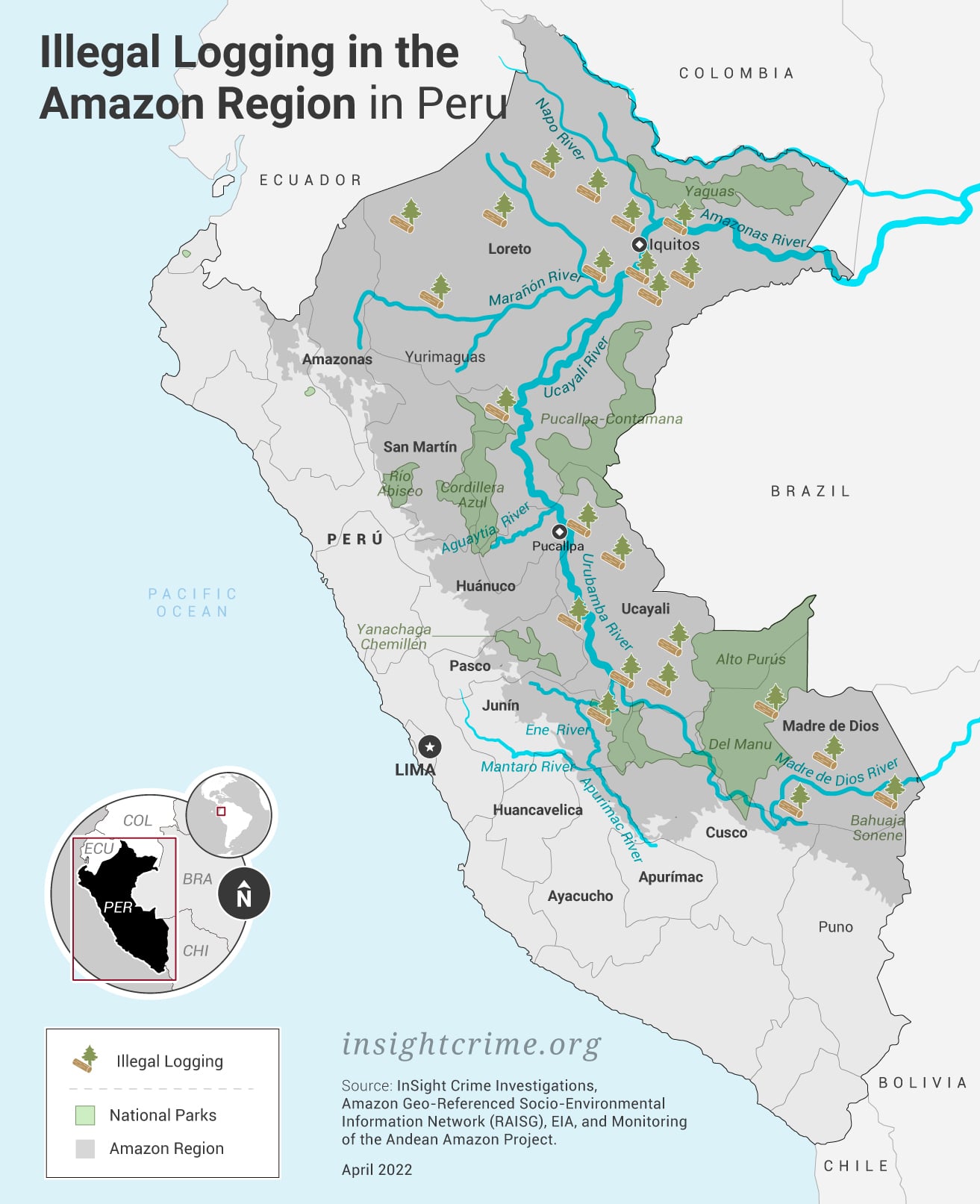
The main wood species extracted in the Peruvian Amazon consist of cumala (Virola calophylla); tornillo (Cedrelinga catenaeformis); cumaru, also known as shihuahuaco (Dipteryx odorata); Lupuna (Chorisia integrifolia); and cachimbo (Cariniana decandra Ducke). While less valuable than cedar and mahogany, these are resistant hardwoods, which are used for the manufacture of luxury furniture that is mostly sold on the local market. Lighter woods — less valuable but still desirable in international markets — have also been targeted by timber traffickers. This is the case of balsa wood, a species increasingly extracted since 2020 due to high demand for the construction of wind turbine blades.
Some of this illegal logging is the result of other legal and illegal activities happening in the Amazon, namely coca cultivation, unauthorized colonization by small farmers and agricultural development. But some of it is part of an explicit plan to traffic timber. In either case, the timber production chain involves three steps: extraction, transport and processing. Illegal wood is laundered into the legal supply chain in each of these phases to cover up illicit origins.
During the extraction phase, authorized logging zones – concessions, Indigenous communities and Local Forests – must submit Annual Operating Plans (Planes Operativos Anuales – POAs). The POAs are supposed to act as controls. They include geo-referenced information and details about the timber species to be harvested, as well as the volume to be extracted. In practice, however, these POAs are used as cover for illegally logged timber in lands where no logging concessions exist or in protected natural reserves, where logging is prohibited.
The wood is then transported to transit and processing hubs, like Pucallpa, the capital of the Ucayali department, and Iquitos, the capital of Loreto. Wood transport must be supported by a timber transport permit (Guía de Transporte Forestal – GTF), a document issued by the regional forestry authorities containing information on the origins of the timber. However, the GTFs can be doctored or falsified by regional ATFFS.
In the processing hubs, the wood is transformed into boards, beams or furniture by legal – and clandestine – sawmills, which effectively fold the sawn wood into the legal supply chain. The sawmills use multiple means to camouflage their illegal activities, including falsifying the registries that show the amount of wood entering and leaving their facility. The forestry authorities are also corrupted in this part of the process.
As well as being another driver of deforestation, timber trafficking is one of the motors behind biodiversity loss, forest degradation and violence in the Peruvian Amazon. High value woods such as cedar and mahogany have been felled without control, almost to the point of extinction. What’s more, the looting of the forests of Indigenous territories by timber traffickers who pursue the most valuable species has led to a violent hunt for Indigenous environmental leaders who oppose timber trafficking in the Amazon.
Actors: The Many Faces of Environmental Crime in Peru
There are many actors driving deforestation in the Peruvian Amazon through their involvement in agro-industrial farms and ranching, illegal logging and drug trafficking. Parsing out which ones are behind the bulk of the deforestation is difficult, but they can be divided into three main categories: big businesses, entrepreneurial criminal networks and cheap labor.
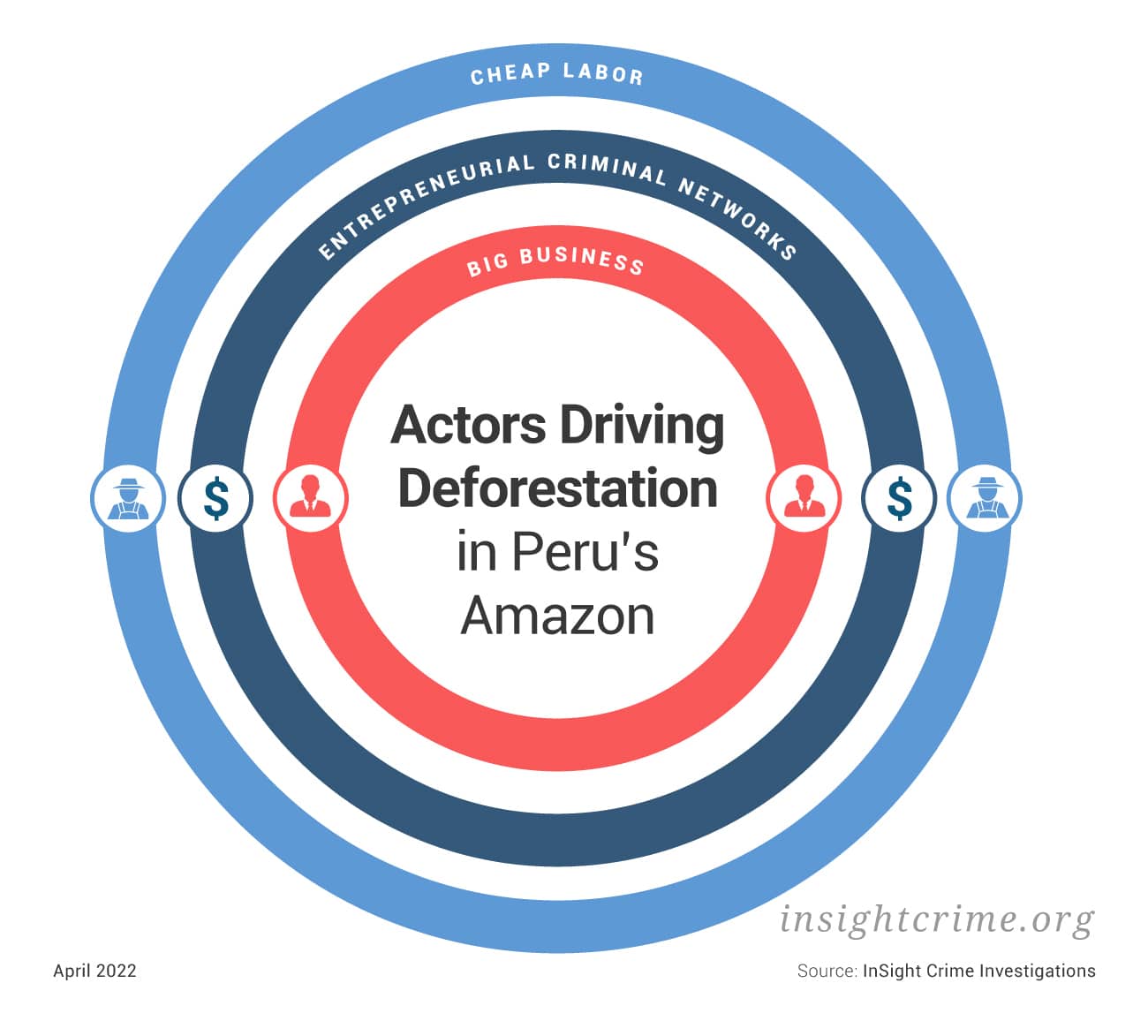
Some big businesses operating at the top of the timber supply chains or running agro-industrial farms are the major actors at the heart of deforestation in the Peruvian Amazon. These businesses are satisfying the demand, both domestic and international, for palm oil, cocoa and wood. They regularly maintain distance from the environmental crimes they promote, hiding behind shell companies, using falsified documentation and working with middlemen and complicit state authorities.
Cases of conglomerates such as the Melka Group (Grupo Melka), owned by Czech-American businessman Dennis Melka, and Romero Group (Grupo Romero) are good illustrations of this process. These companies have traditionally operated in Malaysia and Indonesia, countries with high levels of deforestation due to agro-industrial activities. They arrived in the Peruvian Amazon to harvest palm oil and cocoa. But an extensive investigation by journalists Milagros Salazar and Dánae Rivadeneyra reportedly showed how these companies have deforested thousands of hectares of forest in the departments of Loreto and Ucayali.
They first encroached upon Amazon communities by establishing contact via third parties with land invaders – entrepreneurial criminal networks who, often under the threat or outright use of violence, displace the local population from the territory. Masquerading as farmers, the invaders then seized and clear-cut the forest. These invaders then retroactively requested a certificate of land ownership from the DRA and sold the lands to companies such as the Melka Group, which then used it for agribusiness ventures. Indeed, according to Ojo Público, government officials sold plots of land obtained from different land trafficking schemes to companies like Ocho Sur SAC.
Still, it is difficult to say who is directly responsible for the deforestation. Subsidiaries of Melka Group, including Ocho Sur and Cacao Norte – now called Tamshi SAC – have been accused of deforesting more than 13,000 hectares in the departments of Loreto and Ucayali since 2013. And on July 25, 2019, a Loreto court sentenced Melka’s company Cacao Norte to pay 15 million soles (more than $3 million) in restitution to the State for the deforestation caused by the company.
However, in a 2015 interview with Directors Talk Interviews, an organization dedicated to providing interviews with top executives in publicly-traded companies, Melka denied the accusations and said the area they purchased had already been deforested.
“By the time the plantation companies actually get to the land, that land has been logged or clear cut of all tropical hardwood. It’s simply not a rainforest,” Melka representatives said.
What’s more, in December 2020, the Criminal Appeals Chamber of the Superior Court of Justice (La Sala Penal de Apelaciones de la Corte Superior de Justicia) of Loreto annulled the lower court’s decision. Experts in environmental crime were furious after the high court’s ruling.
“This is frustrating. We expected an exemplary sentence,” Julio Guzmán, attorney for Peru’s Ministry of the Environment, said to Mongabay. “It is a serious blow to the fight against deforestation.”
Environmental watchdogs and media reports suggest that the Romero Group, which consists of the industrial businesses of Espino, Alicorp SA, Trading SA and Sociedad Industrial Yurimaguas SAC (today Industrias del Shanusi SA), has employed a similar strategy to the Melka Group. According to an investigation by the Forest Peoples Programme, an organization that supports Indigenous communities and forest management, Romero Group has invaded historically Indigenous territories such as Nueva Italia, in the department of Junín, and the Kechwa and Shawi Indigenous communities in San Martín, Ucayali, and Loreto.
As in the Melka Group case, Peruvian authorities claimed some companies within the Romero Group, such as Palmas del Shanusi and Palmas-Barranquita, razed hundreds of hectares of forest in Loreto and San Martín. The case also followed the same pattern: Romero Group denied responsibility, and, after a series of public hearings, a local court acquitted them of the charges.
Other companies have also played an important role in timber trafficking by providing infrastructure, such as building roads that are not properly permitted for loggers. They also launder illegally sourced timber through their concessions or with legitimate timber transport permits (GTFs) containing fraudulent information. The permits are issued by their contacts in the regulatory agency, the ATFFS.
GTFs have been used by companies as a kind of certificate of the timber’s legal origins. Once the timber is laundered, it is then processed and sold. Exporters also sometimes buy illegal timber extracted from the Amazon. These exporters and other end-users hide their timber trafficking operations behind legitimate paperwork, such as the GTFs.
“As long as the documents say it is legal, and the state forestry agencies haven’t proven otherwise, then they are ‘good faith buyers,’” according to a 2020 InSight Crime investigation on timber trafficking in Peru.
This is what happened in the emblematic case of Yacu Kallpa. The case was named for the vessel on which the largest seizure of illegally-sourced timber in Peru’s history took place in January 2016 in Mexico’s port of Tampico, on its way to Houston, Texas. Exporters of almost 9,500 cubic meters of illegally-harvested timber claimed they bought the wood in “good faith” and that it had the appropriate documentation. Nevertheless, Peruvian regulators from OSINFOR later showed that 96 percent of the timber shipment was of illegal origin. What’s more, an investigation by Global Witness, an environmental watchdog, uncovered how the representatives of the main exporting companies of the wood on the Yacu Kallpa — such as Inversiones La Oroza and Inversiones WCA — were aware of the illegal origin of the wood by the time it was exported.
Entrepreneurial Criminal Networks
The entrepreneurial criminal networks are market-driven and motivated by profits from the trade in timber, land or drugs. These networks finance and coordinate environmental crimes in the Peruvian Amazon while relying on the work of intermediaries and abundant cheap labor. These networks are dynamic, and their leaders often prefer to remain anonymous. They also conspire with corrupt authorities to carry out illegal activities.
Some of these networks are led by the patrones (bosses). Patrones is a euphemism for those who serve as the brains and capital behind timber trafficking operations. The patron can also be a broker for the big companies that supply national and international markets, especially for larger operations that require technical capacity, transport and machinery.
“The patrones are one of the major enablers of timber trafficking in the Peruvian Amazon,” explained Rolando Navarro, the former director of Osinfor.
The patrones’ job stretches the length of the illicit value chain. They receive and execute orders for larger companies by financing local logging ventures. This includes an upfront payment — with fuel, supplies and cash advances — to logging crews. These payments are used to pay laborers and cooks, as well as those responsible for clearing paths. They also pay for the chainsaws and equipment needed for their operations. It can sometimes lead to a kind of debt peonage system, with laborers falling hopelessly into debt when they cannot fill an order or via deception on the part of large-scale or small-scale patrones. Over time, it has taken on a name: sistema de habilitación (habilitation system).
Patrones can fill other roles as well. They can hire trusted transporters who know they are part of a timber trafficking operation and will pay bribes to authorities at checkpoints. The patrones can employ fixers, or intermediaries, who will take charge of filling in and organizing fraudulent documents. These fixers often have connections with the forestry authorities. In one example, a fixer named Norma Chuquipiondo Carillo, alias “Tia Norma,” or “Aunt Norma,” handled the paperwork needed to launder illegally-sourced timber in Ucayali. Her resources included books of blank but signed processing reports from sawmills, falsified logging contracts and official stamps from the forestry authorities, among other illegal documentation.
Land traffickers and drug traffickers also facilitate deforestation. They illegally seize lands throughout the Amazon, often in Indigenous reserves and protected forests, and then they legalize the properties in their name or in the names of third-party operators. As previously mentioned, these networks often cut and burn the forests. Sometimes they use the land for agriculture or for cattle, and then sell it to small farmers or to large agribusiness. Sometimes they steal the land and sell it right away.
For their part, authorities blame the rise of drug trafficking operations in the Amazon on small family clans. Peruvian authorities have identified about 50 such clans, many of which have been around for a decade or more. They not only control drug production but also infrastructure, such as clandestine airstrips. In the VRAEM, these clans have the protection of the Shining Path (Sendero Luminoso), or the Militarized Communist Party of Peru (Militarizado Partido Comunista de Peru – MPCP), the most organized and lethal non-state armed group (NSAG) in Peru. But in other areas, they operate independently.
Cheap Labor
Part of what fuels the deforestation is the widespread availability of cheap labor. Workers cut down trees, burn forests, plant coca crops and transport timber. They often receive little payment for their work and are often victims of forced labor, particularly those in logging, and they can fall into a debt peonage system via their relationship with the aforementioned patrones.
While these people are employees of entrepreneurial criminal networks, they are not necessarily members of these criminal networks. They often participate in these environmental crimes due to a lack of economic alternatives or pressure from the patrones. Some members of Indigenous communities residing in the Peruvian Amazon, for example, have been subjected to forced labor, especially amid timber trafficking operations.
The labor force for illegal logging is composed mainly of cutters, cooks and those responsible for clearing trails. According to the Environmental Investigation Agency (EIA), an organization dedicated to the study of environmental crime and the destruction of the environment, workers usually enter the timber supply chain on the promise of a well-paying job. However, they often find themselves immersed in conditions of forced slavery and sexual exploitation.
When it comes to drug trafficking, the labor force consists of clearers who are employed to cut and burn the forest to make way for the coca crops. This role is often created once the land is trafficked and occupied by land invaders. The farmers who come to occupy the land then plant the coca leaf. Some workers are employed to help build infrastructure such as clandestine airstrips. Many farmers camouflage coca bushes among their licit crops, as it is more profitable to plant coca than harvest licit crops. According to an investigation by Ojo Público, farmers can earn about $12 a day working on a coffee plantation, while they receive more than double that for coca.
*Elisabetta Marinoni and Scott Mistler-Ferguson contributed to this investigation
*InSight Crime has partnered with the Igarapé Institute – an independent think tank headquartered in Brazil, that focuses on emerging development, security and climate issues – to trace the environmental crimes and criminal actors driving deforestation in Peru’s Amazon. See the entire six-part series here.
